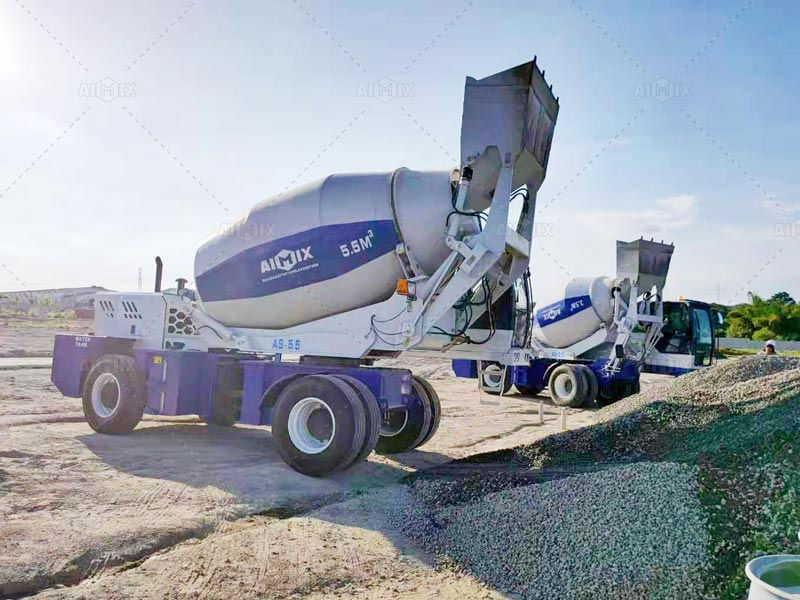How Does a Self-Loading Concrete Mixer Reduce Labor Costs?
- aimixglobal2024
- 2024年9月2日
- 讀畢需時 3 分鐘
In the construction industry, managing labor costs is crucial for maintaining profitability. One effective way to achieve this is by using a self-loading concrete mixer. This versatile machine combines multiple functions, significantly reducing the need for manual labor. In this article, we will explore how a self-loading mixer machine can help reduce labor costs and enhance overall efficiency on construction sites.

Combining Multiple Functions
A self-loading concrete mixer integrates several key functions into one machine. This reduces the need for multiple pieces of equipment and additional labor. Let’s delve into how this integration helps cut labor costs.
Loading Materials
Traditional concrete mixing methods require separate equipment for loading materials into the mixer. This usually involves manual labor to operate loaders or shovels. A self-loading concrete mixer eliminates this need by incorporating a loading bucket. This bucket scoops up raw materials like sand, gravel, and cement, reducing the need for extra labor.
By automating the loading process, the mixer not only saves time but also minimizes the number of workers needed on-site. This directly impacts labor costs, allowing construction projects to stay within budget.
Mixing Concrete
Once the materials are loaded, the self-loading mixer automatically mixes them in the drum. Traditional methods often require manual labor to monitor and adjust the mix. The automated mixing function ensures a consistent and high-quality mix, reducing the need for manual intervention.
This automation helps contractors save on labor costs by reducing the number of workers needed to oversee the mixing process. It also ensures a more efficient and accurate mix, enhancing overall productivity.
Transporting and Discharging
After mixing, the self-loading concrete mixer transports the concrete to the desired location. Traditional methods often require additional labor to transport and pour the concrete. The mixer’s integrated transport and discharge functions eliminate this need, further reducing labor costs.
The machine can easily move around the construction site, delivering concrete precisely where it’s needed. This reduces the time and effort required for manual transportation and pouring, contributing to overall cost savings.
You can know more information about self-loading concrete mixer by opening this page.

Enhancing Efficiency and Productivity
The efficiency and productivity offered by a self-loading concrete mixer play a significant role in reducing labor costs. Let’s explore how these factors contribute to cost savings.
Speed and Precision
A self-loading concrete mixer operates faster and more accurately than traditional methods. Its automated functions ensure quick and precise mixing, transportation, and pouring. This speed and precision minimize the time required for each task, reducing the need for additional labor.
By completing tasks more efficiently, the mixer helps contractors save on labor costs and complete projects within shorter timelines. This enhances overall productivity and profitability.
Reduced Downtime
Traditional concrete mixing methods often involve downtime due to equipment changes, manual loading, and mixing adjustments. A self-loading concrete mixer reduces downtime by integrating these functions into one machine. This continuous operation minimizes delays and ensures a steady workflow.
Reduced downtime translates to fewer labor hours spent waiting for equipment or materials. This directly impacts labor costs, allowing for more efficient use of workers' time and resources.
Versatility and Adaptability
The versatility and adaptability of a self-loading concrete mixer further contribute to cost savings. Its ability to handle various tasks and adapt to different project requirements reduces the need for specialized labor.
Contractors can rely on a smaller, more versatile workforce to operate the mixer and complete tasks. This flexibility helps manage labor costs and ensures efficient use of available resources.
Long-Term Cost Savings
Investing in a self-loading concrete mixer offers long-term cost savings beyond immediate labor reductions. Let’s explore how this investment benefits contractors in the long run.
Durability and Reliability
High-quality self-loading concrete mixers are built to withstand tough conditions and heavy use. Their durability and reliability reduce the need for frequent repairs and replacements. This longevity translates to lower maintenance and operational costs over time.
By minimizing downtime and repair costs, the mixer ensures consistent performance and long-term cost savings. This reliability enhances overall profitability and return on investment.
Reduced Training Costs
The intuitive design and automated functions of a self-loading concrete mixer simplify operation. This reduces the need for extensive training and specialized skills. Contractors can save on training costs and quickly get new operators up to speed.
By reducing the time and resources required for training, the mixer contributes to overall cost savings and operational efficiency.
Conclusion
A self-loading concrete mixer offers significant benefits in reducing labor costs and enhancing efficiency. Its ability to combine multiple functions into one machine minimizes the need for manual labor. The speed, precision, and versatility of the mixer contribute to overall productivity and cost savings.
Investing in a self-loading concrete mixer provides long-term benefits, including durability, reliability, and reduced training costs. Understanding how this versatile machine can help manage labor costs allows contractors to make informed decisions and enhance profitability.




留言